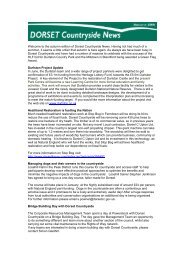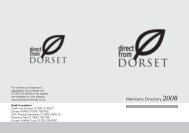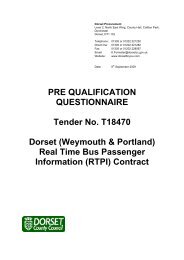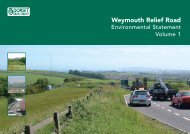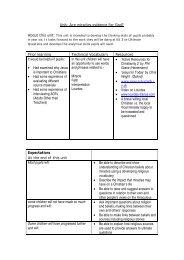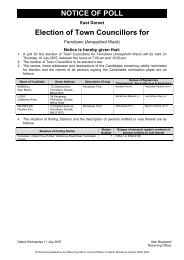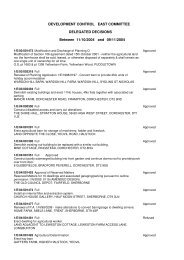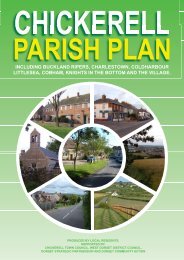west dorset a profile of the economy and labour ... - Dorsetforyou.com
west dorset a profile of the economy and labour ... - Dorsetforyou.com
west dorset a profile of the economy and labour ... - Dorsetforyou.com
You also want an ePaper? Increase the reach of your titles
YUMPU automatically turns print PDFs into web optimized ePapers that Google loves.
WEST DORSET<br />
A PROFILE OF THE ECONOMY AND LABOUR<br />
MARKET<br />
Rosie Martin, Nikki Taylor <strong>and</strong> Anne Gray<br />
Research <strong>and</strong> Information Group<br />
Dorset County Council<br />
(01305) 224575<br />
November 2008<br />
Front cover: South Street, Dorchester
BUSINESS AND ECONOMY<br />
Economic growth<br />
Gross Value Added (GVA) measures <strong>the</strong> contribution to <strong>the</strong> <strong>economy</strong> <strong>of</strong> each<br />
individual producer, industry or sector in <strong>the</strong> UK by estimating <strong>the</strong> value <strong>of</strong> its outputs<br />
(goods <strong>and</strong> services), less purchases <strong>and</strong> less net spending taxes.<br />
Crude local estimates <strong>of</strong> GVA can be derived from this NUTS3 level data by<br />
allocating it in proportion to <strong>the</strong> distribution <strong>of</strong> full time equivalent employee numbers,<br />
weighted for high productivity, based on Annual Business Inquiry survey data.<br />
These local estimates indicate that GVA in West Dorset is around £1,310 million.<br />
This is just over one-quarter <strong>of</strong> DCC Dorset’s total GVA.<br />
GVA (Gross Value Added 1 ) per resident head is low in DCC Dorset at 71 per cent <strong>of</strong><br />
<strong>the</strong> Engl<strong>and</strong> average 2 <strong>and</strong> 78 per cent <strong>of</strong> <strong>the</strong> regional level. Estimated GVA per<br />
resident head in West Dorset falls above <strong>the</strong> DCC Dorset average in all years.<br />
Headline GVA: £ per head <strong>of</strong> resident population - local estimates<br />
£ 1998 1999 2000 2001 2002 2003 2004 2005<br />
Dorset sub-region: 10,600 11,300 11,700 12,300 12,700 13,500 14,300 14,900<br />
Bournemouth 12,100 13,000 13,800 14,400 14,800 15,700 16,500 16,800<br />
Poole 12,100 13,000 13,500 14,100 14,900 15,800 17,000 18,000<br />
DCC Dorset 9,383 9,909 10,268 10,725 11,092 11,720 12,504 13,059<br />
Christchurch 10,800 11,400 12,000 11,800 12,200 13,500 14,500 15,200<br />
East Dorset 8,800 9,800 9,700 10,700 10,700 11,400 12,300 13,000<br />
North Dorset 8,300 9,200 9,900 10,300 11,700 11,400 12,000 11,800<br />
Purbeck 9,500 10,300 10,800 10,500 10,200 13,200 14,300 15,600<br />
West Dorset 11,000 11,700 11,100 12,700 13,000 12,600 13,300 13,700<br />
Weymouth <strong>and</strong> Portl<strong>and</strong> 7,700 7,000 8,600 7,700 8,200 9,000 9,500 10,100<br />
Headline GVA: £ per head <strong>of</strong> resident population – ONS data<br />
£ 1998 1999 2000 2001 2002 2003 2004 2005<br />
Bournemouth & Poole 12,095 13,022 13,642 14,285 14,877 15,767 16,737 17,378<br />
DCC Dorset 9,383 9,909 10,268 10,725 11,092 11,720 12,504 13,059<br />
UK 13,144 13,734 14,378 15,040 15,800 16,682 17,577 18,205<br />
South East 13,769 14,532 15,218 16,088 16,901 17,844 18,804 19,434<br />
South West 11,999 12,525 12,999 13,709 14,439 15,306 16,175 16,688<br />
Engl<strong>and</strong> 13,222 13,817 14,350 15,060 15,853 16,759 17,672 18,267<br />
Source: Office for National Statistics with DCC Dorset estimates (Dorset County Council)<br />
Dorset’s level <strong>of</strong> economic growth is generally at a rate lower than that <strong>of</strong> <strong>the</strong> South<br />
West region as a whole. Growth for <strong>the</strong> next decade (2006-2016) in <strong>the</strong> South West<br />
region is projected to continue at around three per cent per annum, <strong>the</strong> same as in<br />
<strong>the</strong> previous ten years 3 . Projections <strong>of</strong> GVA are not available at local authority level,<br />
but growth in Dorset is most likely to take place in <strong>the</strong> south <strong>and</strong> east.<br />
1 GVA measures <strong>the</strong> contribution <strong>of</strong> each individual producer, or sector, to <strong>the</strong> <strong>economy</strong> by estimating<br />
<strong>the</strong> value <strong>of</strong> its outputs (goods <strong>and</strong> services – as above), less purchases <strong>and</strong> less net spending taxes. It<br />
relates to Gross Domestic Product (GDP) in <strong>the</strong> following way: GVA plus taxes on products less<br />
subsidies on products equals GDP.<br />
2 ONS Headline GVA per resident head at current basic prices<br />
3 Cambridge Econometrics – Local Economy Forecasting Model 2005 (SWRA Scenario 1)
Business structure<br />
West Dorset has approximately 4,650 firms, excluding <strong>the</strong> self-employed 4 . 4,430<br />
firms were registered for VAT in 2006 5 .<br />
86 per cent <strong>of</strong> firms are micro-firms (employing fewer than ten employees) <strong>and</strong><br />
<strong>the</strong>se account for 29 per cent <strong>of</strong> total employment in <strong>the</strong> district. This is much in line<br />
with <strong>the</strong> average for DCC Dorset, (87 per cent <strong>and</strong> 30 per cent respectively).<br />
Less than one per cent <strong>of</strong> firms employ 200 or more employees, much <strong>the</strong> same as<br />
<strong>the</strong> DCC Dorset average <strong>of</strong> 0.4 per cent.<br />
Although <strong>the</strong> majority <strong>of</strong> firms are ‘small’, larger firms employ a significant proportion<br />
<strong>of</strong> <strong>the</strong> workforce. Just three per cent <strong>of</strong> West Dorset’s firms, (those with 50 or more<br />
employees), account for 44 per cent <strong>of</strong> employees in employment in <strong>the</strong> district.<br />
West Dorset’s rate <strong>of</strong> business formation 6 is below that <strong>of</strong> DCC Dorset, 7.1 per<br />
cent representing 310 firms newly registering for VAT in 2006 7 . At 7.9 per cent,<br />
business formation in DCC Dorset is below <strong>the</strong> regional <strong>and</strong> national averages, (8.8<br />
per cent <strong>and</strong> 9.7 per cent respectively).<br />
However, in terms <strong>of</strong> VAT registrations per thous<strong>and</strong> <strong>of</strong> <strong>the</strong> population <strong>of</strong> working<br />
age, DCC Dorset ranks above <strong>the</strong> national <strong>and</strong> regional averages <strong>and</strong> <strong>the</strong> figure for<br />
West Dorset is slightly above <strong>the</strong> local average at 6.0 registrations per 1,000.<br />
VAT registrations 2006 per 1,000 w orking age population<br />
8.0<br />
7.0<br />
6.0<br />
5.0<br />
4.0<br />
3.0<br />
2.0<br />
1.0<br />
0.0<br />
Engl<strong>and</strong><br />
average<br />
Engl<strong>and</strong><br />
South West<br />
Bournemouth<br />
DCC Dorset<br />
Poole<br />
Dorset subregion<br />
Christchurch<br />
East Dorset<br />
North Dorset<br />
Purbeck<br />
West Dorset<br />
Weymouth &<br />
Portl<strong>and</strong><br />
Sources: Mid 2006 population estimates <strong>and</strong> VAT registration data 2006, ONS<br />
4 Annual Business Inquiry 2006, ONS<br />
5 ONS/DTI VAT registrations 2006<br />
6 number <strong>of</strong> businesses registered for VAT as % <strong>of</strong> stocks at <strong>the</strong> beginning <strong>of</strong> <strong>the</strong> year<br />
7 ONS/DTI VAT registrations
LABOUR MARKET<br />
Structure<br />
The Census <strong>of</strong> Population 2001 indicated that West Dorset had around 41,200<br />
economically active people aged 16-74 years. With 36.2 per cent <strong>of</strong> 16-74 year<br />
olds economically inactive, West Dorset has a slightly below average level <strong>of</strong><br />
economic activity.<br />
72.8 per cent <strong>of</strong> <strong>the</strong> economically active were in employment, below <strong>the</strong> DCC Dorset<br />
average <strong>of</strong> 76.1 per cent. Self-employment was above <strong>the</strong> DCC Dorset average.<br />
Of <strong>the</strong> economically inactive in West Dorset, 57 per cent were retired, just above <strong>the</strong><br />
DCC Dorset average. There was also a higher proportion <strong>of</strong> economically inactive<br />
students.<br />
Labour market structure in 2001: West Dorset DCC Dorset<br />
All people aged 16 - 74 64,658 275,193<br />
Economically active 41,228 63.8% 178,519 64.9%<br />
Economically inactive 23,430 36.2% 96,674 35.1%<br />
Economically active 16-74:<br />
Employees: Part-time 8 8,726 21.2% 37,236 20.9%<br />
Employees: Full-time 21,271 51.6% 98,696 55.3%<br />
Self - employed 8,875 21.5% 31,446 17.6%<br />
Unemployed 1,229 3.0% 5,596 3.1%<br />
Full-time student 1,127 2.7% 5,545 3.1%<br />
Economically inactive 16-74:<br />
Retired 13,352 57.0% 54,255 56.1%<br />
Student 2,188 9.3% 7,625 7.9%<br />
Looking after home/family 3,862 16.5% 16,908 17.5%<br />
Permanently sick/disabled 2,554 10.9% 11,026 11.4%<br />
O<strong>the</strong>r 1,474 6.3% 6,860 7.1%<br />
Source: Census <strong>of</strong> Population 2001, ONS Copyright Reserved<br />
The following extract from <strong>the</strong> Annual Population Survey suggests that economic<br />
activity has increased with around 83 per cent <strong>of</strong> West Dorset’s working age<br />
population economically active, although <strong>the</strong> age b<strong>and</strong>ing is different to that used in<br />
<strong>the</strong> Census. This is much <strong>the</strong> same as in DCC Dorset generally, taking <strong>the</strong> potential<br />
range into account. The estimate for DCC Dorset is 81.8 per cent plus or minus 2.6<br />
giving a range <strong>of</strong> 79.2 to 84.4 per cent. There is only one chance in twenty that <strong>the</strong><br />
true value will lie outside this range. In West Dorset, <strong>the</strong> confidence level is 5.1<br />
giving a range <strong>of</strong> 77.8 to 88.0 per cent – overlapping <strong>the</strong> DCC Dorset range.<br />
8 For <strong>the</strong> Census; part-time employment is defined as working 30 hours or less a week. Full-time is<br />
defined as working 31 or more hours a week.
Labour Market Structure West Dorset DCC Dorset<br />
number denominator percent confidence number denominator percent confidence<br />
All:<br />
Economic activity rate - working age 42,700 51,500 82.9 5.1 179,100 218,800 81.8 2.6<br />
Employment rate - working age 41,500 51,500 80.5 5.4 172,500 218,800 78.9 2.7<br />
% <strong>of</strong> working age who are employees 34,100 51,500 66.3 6.4 145,600 218,800 66.6 3.2<br />
% <strong>of</strong> working age who are self employed 7,100 51,500 13.8 4.7 25,800 218,800 11.8 2.2<br />
Unemployment rate - working age 1,200 42,700 2.9 * 6,500 179,100 3.7 1.4<br />
% who are economically inactive - working age 8,800 51,500 17.1 5.1 39,700 218,800 18.2 2.6<br />
Males:<br />
Economic activity rate males - working age 23,600 27,100 87.0 6.3 96,700 114,800 84.3 3.4<br />
Employment rate males - working age 22,800 27,100 84.3 6.8 92,800 114,800 80.9 3.6<br />
% <strong>of</strong> working age males who are employees 16,700 27,100 61.8 9.0 71,900 114,800 62.6 4.5<br />
% <strong>of</strong> working age males who are self employed 5,900 27,100 21.6 7.7 20,200 114,800 17.6 3.5<br />
Unemployment rate males - working age 700 23,600 3.1 * 3,900 96,700 4.0 2.0<br />
% <strong>of</strong> males who are economically inactive - working age 3,500 27,100 13.0 6.3 18,100 114,800 15.7 3.4<br />
Females:<br />
Economic activity rate females - working age 19,100 24,400 78.4 8.2 82,300 104,000 79.2 4.0<br />
Employment rate females - working age 18,600 24,400 76.3 8.4 79,700 104,000 76.6 4.1<br />
% <strong>of</strong> working age females who are employees 17,400 24,400 71.2 9.0 73,700 104,000 70.9 4.4<br />
% <strong>of</strong> working age females who are self employed 1,200 24,400 5.1 * 5,600 104,000 5.4 2.2<br />
Unemployment rate females - working age ! 19,100 ! ! 2,600 82,300 3.2 1.9<br />
% <strong>of</strong> females who are economically inactive - working age 5,300 24,400 21.6 8.2 21,700 104,000 20.8 4.0<br />
Source: Annual Population Survey, January-December 2007, ONS Copyright Reserved<br />
! Estimate <strong>and</strong> confidence interval not available since <strong>the</strong> group sample size is zero or disclosive (0-2).<br />
* Estimate <strong>and</strong> confidence interval unreliable since <strong>the</strong> group sample size is small (3-9).<br />
WARNING: Data prior to <strong>the</strong> period Oct 06 - Sep 07 has not been reweighted in line with <strong>the</strong> latest ONS estimates. This will be done as soon as possible For fur<strong>the</strong>r details go<br />
to http://www.nomisweb.co.uk/articles/366.aspx.<br />
For unemployment rates <strong>and</strong> levels for districts <strong>and</strong> unitary authorities ONS re<strong>com</strong>mend <strong>the</strong> use <strong>of</strong> <strong>the</strong>ir model-based estimates which provide a more precise measure. For<br />
fur<strong>the</strong>r details go to http://www.statistics.gov.uk/STATBASE/Product.aspvlnk=13574.
Working age population<br />
Mid year population estimates for 2007 give a working age population 9 <strong>of</strong><br />
approximately 52,000. This makes up a marginally below average percentage <strong>of</strong><br />
West Dorset’s total population <strong>of</strong> 97,100, 54% aged 16-59/64 years as against 55%<br />
in DCC Dorset as a whole.<br />
The proportion over retirement age is just above average in West Dorset: 29%<br />
<strong>com</strong>pared with 28% in DCC Dorset as a whole.<br />
Between 1997 <strong>and</strong> 2007, <strong>the</strong> retirement age population in West Dorset grew by 16<br />
per cent, marginally above <strong>the</strong> DCC Dorset average <strong>of</strong> 15 per cent over <strong>the</strong> decade.<br />
2007 age <strong>pr<strong>of</strong>ile</strong><br />
Below w orking age<br />
Working age<br />
Above w orking age<br />
West Dorset<br />
17.2%<br />
53.6%<br />
29.2%<br />
DCC Dorset<br />
17.1%<br />
54.9%<br />
28.0%<br />
South West<br />
17.8%<br />
60.1%<br />
22.1%<br />
Great Britain<br />
18.8%<br />
62.2%<br />
19.0%<br />
0% 10% 20% 30% 40% 50% 60% 70% 80% 90% 100%<br />
per cent <strong>of</strong> all<br />
Source: ONS mid-year population estimates, 2007<br />
Commuting<br />
The Census <strong>of</strong> Population shows that both in 1991 <strong>and</strong> in 2001 West Dorset had a<br />
net gain <strong>of</strong> <strong>com</strong>muters: <strong>the</strong>re were fewer people <strong>com</strong>muting out <strong>of</strong> <strong>the</strong> District than<br />
in. Over <strong>the</strong> decade, <strong>the</strong> position remained unchanged. In 1991 10 , West Dorset<br />
showed a net gain <strong>of</strong> around 2,500 <strong>com</strong>muters <strong>and</strong> this was <strong>the</strong> same in 2001.<br />
However, <strong>the</strong> volume <strong>of</strong> <strong>com</strong>muting both in <strong>and</strong> out <strong>of</strong> <strong>the</strong> District increased. In <strong>the</strong><br />
DCC Dorset area, only Christchurch <strong>and</strong> West Dorset are net importers <strong>of</strong><br />
<strong>com</strong>muters.<br />
In 2001, West Dorset had 13,700 in-<strong>com</strong>muters. More than half <strong>of</strong> <strong>the</strong>se<br />
<strong>com</strong>muters came from Weymouth & Portl<strong>and</strong>. A fur<strong>the</strong>r 20 per cent came from<br />
Somerset.<br />
11,200 West Dorset residents <strong>com</strong>muted out <strong>of</strong> <strong>the</strong> District for work, again largely<br />
to Somerset <strong>and</strong> to Weymouth & Portl<strong>and</strong>.<br />
9 Women aged 16-59 <strong>and</strong> men aged 16-64<br />
10 There are some problems in <strong>com</strong>paring <strong>the</strong> 1991 <strong>and</strong> 2001 <strong>com</strong>muting data, mainly because in 1991<br />
<strong>the</strong>se data were only collected from a 10 per cent sample <strong>of</strong> <strong>the</strong> population. Exact figures should not be<br />
<strong>com</strong>pared but an idea <strong>of</strong> trends can be gained.
28,770 people both lived <strong>and</strong> worked in West Dorset, 72% <strong>of</strong> resident workers<br />
<strong>com</strong>pared with 73% in DCC Dorset as a whole.<br />
Commuting flows 2001: West Dorset<br />
7069<br />
Number <strong>of</strong> <strong>com</strong>muters<br />
3863<br />
2703<br />
2230<br />
Out <strong>com</strong>muting<br />
In <strong>com</strong>muting<br />
1327<br />
1084 989<br />
589<br />
803 771 775<br />
417<br />
589 561<br />
269 337<br />
259 176<br />
So merset<br />
Weymouth<br />
<strong>and</strong> Portl<strong>and</strong><br />
P urbeck<br />
Rest o f DCC Rest o f So uth<br />
West<br />
Elsewhere So uth East P o o le B o urnemouth<br />
Source: Census <strong>of</strong> Population, 1991 <strong>and</strong> 2001<br />
Employment by sector<br />
The West Dorset <strong>economy</strong> is centered on Public services <strong>and</strong> Distribution, hotels<br />
& restaurants, with <strong>the</strong>se two sectors alone accounting for over 60 per cent <strong>of</strong><br />
employment 11 . West Dorset has an above average proportion <strong>of</strong> employment in<br />
public services which accounts for more than one-third (36%) <strong>of</strong> all employees in<br />
employment.<br />
Main Employment Sectors:<br />
Employees % <strong>of</strong> Total Employment<br />
West Dorset DCC<br />
Total Employment 42,200<br />
Public administration, education & health 15,100 35.8% 28.5%<br />
Distribution, hotels <strong>and</strong> restaurants 10,700 25.4% 26.6%<br />
Banking, finance <strong>and</strong> insurance, etc 5,200 12.3% 15.7%<br />
Manufacturing 4,500 10.6% 12.3%<br />
Construction 2,200 5.1% 5.3%<br />
O<strong>the</strong>r services 2,100 4.9% 4.6%<br />
Agriculture <strong>and</strong> fishing 1,200<br />
2.9% 2.3%<br />
Transport <strong>and</strong> <strong>com</strong>munications 1,200<br />
2.8% 4.1%<br />
Energy <strong>and</strong> water C C 0.5%<br />
C: confidential<br />
There are approximately 42,200 employees in West Dorset, almost 30 per cent <strong>of</strong> all<br />
employees in DCC Dorset 12 . 61 per cent <strong>of</strong> <strong>the</strong>se are in full-time employment <strong>and</strong> 45<br />
per cent <strong>of</strong> all employees are male. These proportions are lower than <strong>the</strong> DCC<br />
Dorset averages <strong>of</strong> 62 per cent <strong>and</strong> 50 per cent respectively, reflecting <strong>the</strong> high<br />
proportion working in <strong>the</strong> public sector.<br />
11 Employment data from Annual Business Inquiry 2006 (ONS)<br />
12 Excludes Bournemouth <strong>and</strong> Poole
Four-fifths <strong>of</strong> all employees work in <strong>the</strong> service sector, (81 per cent) 13 , much in line<br />
with <strong>the</strong> DCC Dorset average <strong>of</strong> 80 per cent.<br />
Those employed directly in tourism-related businesses account for seven per cent <strong>of</strong><br />
employment, above <strong>the</strong> average for DCC Dorset (five per cent).<br />
Knowledge-based industries, (pr<strong>of</strong>essional <strong>and</strong> technical), account for 15 per cent <strong>of</strong><br />
employment, just below <strong>the</strong> average for DCC Dorset (17 per cent).<br />
Occupational <strong>pr<strong>of</strong>ile</strong><br />
In West Dorset, Annual Population Survey 14 data indicates that two in five employed<br />
residents work in managerial, pr<strong>of</strong>essional or associate pr<strong>of</strong>essional/ technical<br />
occupations: about <strong>the</strong> same as <strong>the</strong> average for Dorset as a whole.<br />
West Dorset DCC Dorset<br />
All people aged in employment as/in: 45,400 188,600<br />
Managers <strong>and</strong> senior <strong>of</strong>ficials 12.6% 19.8%<br />
Pr<strong>of</strong>essional occupations 14.9% 11.1%<br />
Associate pr<strong>of</strong>essional <strong>and</strong> technical occupations 13.6% 12.6%<br />
Administrative <strong>and</strong> secretarial occupations 11.2% 11.4%<br />
Skilled trades occupations 14.7% 12.9%<br />
Personal service occupations 6.7% 10.7%<br />
Sales <strong>and</strong> customer service occupations 4.9% 5.3%<br />
Process; plant <strong>and</strong> machine operatives 4.7% 4.8%<br />
Elementary occupations 16.2% 11.2%<br />
Source: Annual Population Survey Jan-Dec 2007, ONS<br />
Self-employment<br />
The Census <strong>of</strong> Population 2001 indicated that West Dorset had 8,863 self-employed<br />
residents aged 16-74 years: 21.5 per cent <strong>of</strong> <strong>the</strong> population <strong>of</strong> this age. More recent<br />
data also show that West Dorset has an estimated 9,100 self-employed residents<br />
<strong>of</strong> working age 15 . This is 20 per cent <strong>of</strong> employees aged 16+, noticeably above <strong>the</strong><br />
average for Dorset 16 . More than three-quarters <strong>of</strong> <strong>the</strong> self-employed are male, much<br />
in line with <strong>the</strong> average for DCC Dorset as a whole.<br />
Total employment<br />
Estimates <strong>of</strong> total employment are available from 2000 to 2005. This is a workplace<br />
based measure <strong>of</strong> jobs which <strong>com</strong>prises:<br />
• Employees in employment (from <strong>the</strong> Annual Business Inquiry);<br />
• Self-employed jobs (from <strong>the</strong> Local Area Labour Force Survey/Annual<br />
Population Survey);<br />
• People in government-supported training (from DfES <strong>and</strong> DWP); <strong>and</strong><br />
• HM Forces (from MoD).<br />
13 This excludes Agriculture & fishing; Energy & water; Manufacturing; Construction<br />
14 The Annual Population Survey is a sample survey <strong>and</strong> subject to sample error.<br />
15 Annual Population Survey, (ONS), January-December 2007. Note confidence interval <strong>of</strong> ±5.7%.<br />
16 The APS gives a range within which <strong>the</strong> true value may fall. With a DCC Dorset range <strong>of</strong> between<br />
13.9% <strong>and</strong> 19.3% <strong>of</strong> those aged 16+ being self-employed, all <strong>the</strong> Dorset local authorities overlap this<br />
range.
In 2005, West Dorset had total employment <strong>of</strong> 50,000. Over <strong>the</strong> period 2000 to<br />
2005, total employment rose by 0.8 per cent per annum, although this was not a<br />
steady incline. DCC Dorset as a whole saw marginal growth <strong>of</strong> 0.3% per annum over<br />
<strong>the</strong> five years.<br />
2000 2001 2002 2003 2004 2005<br />
% change<br />
per annum<br />
2000-2005<br />
Great Britain 28,973,000 29,283,000 29,477,000 29,747,000 30,042,000 30,539,000 1.1%<br />
South West 2,464,000 2,543,000 2,571,000 2,597,000 2,616,000 2,643,000 1.4%<br />
Dorset sub-region 333,000 333,000 334,000 340,000 334,000 350,000 1.0%<br />
Bournemouth 83,000 85,000 87,000 89,000 87,000 93,000 2.3%<br />
Poole 73,000 73,000 69,000 73,000 75,000 78,000 1.3%<br />
DCC Dorset 176,000 175,000 178,000 178,000 172,000 179,000 0.3%<br />
Christchurch 22,000 20,000 21,000 25,000 20,000 21,000 -0.9%<br />
East Dorset 33,000 33,000 31,000 34,000 34,000 37,000 2.3%<br />
North Dorset 30,000 30,000 31,000 30,000 29,000 31,000 0.7%<br />
Purbeck 19,000 21,000 19,000 22,000 21,000 19,000 0.0%<br />
West Dorset 48,000 49,000 51,000 47,000 47,000 50,000 0.8%<br />
Weymouth &<br />
Portl<strong>and</strong><br />
24,000 21,000 23,000 21,000 21,000 21,000 -2.6%<br />
Source: ONS Crown Copyright Reserved<br />
Jobs density<br />
Jobs density figures show <strong>the</strong> number <strong>of</strong> jobs <strong>the</strong>re are for each working age resident<br />
in an area. Those areas with lower densities tend to be areas where people live<br />
ra<strong>the</strong>r than work. Areas with jobs density <strong>of</strong> more than one are normally importers <strong>of</strong><br />
<strong>labour</strong>. A jobs density lower than one indicates fewer jobs than working age<br />
residents <strong>and</strong> a propensity to travel out <strong>of</strong> <strong>the</strong> area to work.<br />
The numbers <strong>of</strong> jobs <strong>com</strong>prises:<br />
• employees;<br />
• agricultural employees;<br />
• self-employed jobs;<br />
• Government supported trainees; <strong>and</strong><br />
• HM Forces.<br />
In 2005, <strong>the</strong>re were 0.84 jobs per person <strong>of</strong> working age in Great Britain, up<br />
marginally from 2001. In DCC Dorset, <strong>the</strong>re were 0.81 jobs per person <strong>of</strong> working<br />
age, up from 0.78 in <strong>the</strong> previous year.<br />
Within DCC Dorset, West Dorset had <strong>the</strong> highest jobs density, (9 th in <strong>the</strong> South<br />
West), <strong>and</strong> Weymouth & Portl<strong>and</strong> had <strong>the</strong> lo<strong>west</strong> level in <strong>the</strong> South West, (45 th out <strong>of</strong><br />
45).<br />
Within <strong>the</strong> South West region, Exeter, Isles <strong>of</strong> Scilly, Swindon, Taunton Deane,<br />
Carrick <strong>and</strong> Gloucester all had jobs densities <strong>of</strong> more than one.
Jobs density 2000 2001 2002 2003 2004 2005<br />
Great Britain 0.82 0.83 0.83 0.83 0.83 0.84<br />
South West 0.84 0.86 0.87 0.87 0.87 0.87<br />
Dorset sub-region 0.84 0.84 0.84 0.85 0.83 0.87<br />
Bournemouth 0.86 0.87 0.88 0.89 0.87 0.93<br />
Poole 0.91 0.90 0.86 0.91 0.93 0.97<br />
DCC Dorset 0.81 0.80 0.81 0.81 0.78 0.81<br />
Christchurch 0.97 0.86 0.93 1.07 0.86 0.91<br />
East Dorset 0.73 0.73 0.69 0.74 0.74 0.81<br />
North Dorset 0.83 0.85 0.87 0.82 0.78 0.84<br />
Purbeck 0.75 0.82 0.76 0.87 0.83 0.74<br />
West Dorset 0.96 0.98 1.00 0.91 0.91 0.98<br />
Weymouth &<br />
Portl<strong>and</strong><br />
0.64 0.57 0.61 0.54 0.56 0.55<br />
Source: ONS Crown Copyright Reserved<br />
Second jobs<br />
DCC Dorset is estimated to have around 11,800 people with second jobs 17 , a range<br />
<strong>of</strong> 8,500 -15,100. This is more than twice as many than in <strong>the</strong> Bournemouth <strong>and</strong><br />
Poole <strong>com</strong>bined area. About three–fifths <strong>of</strong> <strong>the</strong>se people with more than one job are<br />
females (61 per cent).<br />
In terms <strong>of</strong> what industries <strong>the</strong>se people work in, 37 per cent are found in <strong>the</strong> Public<br />
administration, education & health sector. More than a fifth works in Distribution,<br />
hotels & restaurants in DCC Dorset.<br />
In West Dorset, approximately 3,600 people have second jobs (1,800-5,400) <strong>and</strong> 61<br />
per cent <strong>of</strong> <strong>the</strong>se are female. More than two-thirds <strong>of</strong> those with second jobs work in<br />
<strong>the</strong> service sector, largely in <strong>the</strong> Public administration, education <strong>and</strong> health sector<br />
<strong>and</strong> Distribution, hotels <strong>and</strong> restaurants 18 .<br />
Employment growth<br />
Over <strong>the</strong> decade from 2006 to 2016, West Dorset is projected to see growth <strong>of</strong><br />
around 0.7 per cent per annum in <strong>the</strong> number <strong>of</strong> employed <strong>and</strong> self-employed jobs<br />
(about 3,300 jobs) 19 . This is in line with <strong>the</strong> 0.7 per cent per annum growth projected<br />
for <strong>the</strong> DCC Dorset area.<br />
Over <strong>the</strong> next two decades, growth is expected to follow much <strong>the</strong> same pattern <strong>and</strong><br />
continue to be service sector led, especially by Education & Health; Distribution; <strong>and</strong><br />
O<strong>the</strong>r Business Services. Employment in Manufacturing <strong>and</strong> in Agriculture is<br />
expected to continue to decline in line with national <strong>and</strong> regional trends.<br />
17 Annual Population Survey January-December 2007, ONS<br />
18 Use with CAUTION – indication only, estimate <strong>and</strong> confidence unreliable since <strong>the</strong> group sample size<br />
is small.<br />
19 Local Economy Forecasting Model 2005, Cambridge Econometrics (SWRA Scenario 1). Note:<br />
projections at this low geographical level should be treated with EXTREME CAUTION.
Employment Growth Estimates: West Dorset<br />
2.5<br />
2.0<br />
Change 2016-2026<br />
Change 2006-2016<br />
1.5<br />
1.0<br />
0.5<br />
0.0<br />
-0.5<br />
-1.0<br />
1 Agriculture etc<br />
7 Electronics<br />
3 Food, Textiles & Wood<br />
2 Mining & Quarrying<br />
5 Chemicals & Minerals<br />
6 Metals & Engineering<br />
8 Transport Equipment<br />
9 Manufacturing nes<br />
10 Electricity, Gas & Water<br />
14 Transport & Comms.<br />
15 Banking & Insurance<br />
4 Printing & Publishing<br />
17 Public Admin. & Defence.<br />
13 Hotels & Catering<br />
11 Construction<br />
19 Miscellaneous Services<br />
16 O<strong>the</strong>r Business Serv.<br />
12 Distribution<br />
18 Education & Health<br />
Thous<strong>and</strong>s<br />
In addition to filling any new jobs, <strong>the</strong>re will also be dem<strong>and</strong>s to replace those<br />
workers who leave <strong>the</strong>ir positions for reasons such as ill-health or retirement – <strong>the</strong><br />
replacement dem<strong>and</strong>. The scale <strong>of</strong> net employment dem<strong>and</strong>, (expansion dem<strong>and</strong><br />
plus replacement dem<strong>and</strong>), is likely to be in <strong>the</strong> region <strong>of</strong> six times expansion<br />
dem<strong>and</strong> alone, largely due to retirement <strong>of</strong> <strong>the</strong> relatively elderly workforce <strong>of</strong> <strong>the</strong><br />
area.<br />
Looking at this by occupation across <strong>the</strong> Dorset sub-region, <strong>the</strong> greatest requirement<br />
is expected in:<br />
• Caring Personal Service Occupations<br />
• Corporate Managers<br />
• Sales Occupations<br />
• Teaching/Research Pr<strong>of</strong>essionals<br />
• Business/Public Service Associate Pr<strong>of</strong>essionals<br />
For <strong>the</strong> purposes <strong>of</strong> skills provision <strong>and</strong> training, it is also worth noting that, even<br />
though some occupations may expected to have negative expansion dem<strong>and</strong>, (eg<br />
clerical occupations <strong>and</strong> skilled metal/electrical trades), <strong>the</strong> need to replace retiring<br />
workers means that <strong>the</strong>re will be a continuing training dem<strong>and</strong> to fill vacancies with<br />
appropriately skilled personnel.<br />
Earnings<br />
Earnings data are now available on a workplace basis or a residence basis 20 .<br />
Workplace based earnings show <strong>the</strong> pay levels available in a particular area.<br />
Residence based earnings look at <strong>the</strong> pay <strong>of</strong> people living in <strong>the</strong> area who may work<br />
in <strong>the</strong> same area or may <strong>com</strong>mute elsewhere. The Annual Survey <strong>of</strong> Hours <strong>and</strong><br />
Earnings is a sample survey <strong>and</strong> subject to sample error, as indicated below.<br />
In 2007 on a workplace basis, median gross weekly earnings for full time<br />
employees on adult rates in West Dorset fall below <strong>the</strong> national <strong>and</strong> regional<br />
20 Annual Survey <strong>of</strong> Hours <strong>and</strong> Earnings 2007, ONS
averages. Applying st<strong>and</strong>ard error data indicates a likely range <strong>of</strong> £339 to £446 per<br />
week. This range falls below <strong>the</strong> national level, as does <strong>the</strong> range for <strong>the</strong> DCC<br />
Dorset area as a whole.<br />
Residence based data suggests gross weekly earnings for full time employees on<br />
adult rates in West Dorset were below <strong>the</strong> regional <strong>and</strong> national averages. Applying<br />
st<strong>and</strong>ard error data indicates a likely range <strong>of</strong> £362 to £489 per week with only a one<br />
in twenty chance <strong>of</strong> earnings falling outside this. This overlaps with <strong>the</strong> ranges for<br />
<strong>the</strong> wider geographies so no real difference can be discerned. In addition, <strong>the</strong><br />
workplace <strong>and</strong> residence based data for West Dorset also overlap each o<strong>the</strong>r<br />
allowing no real distinction to be made between <strong>the</strong> two.<br />
Average gross weekly pay for full-time employees (median)<br />
Workplace<br />
based<br />
Residence<br />
based<br />
UK £ 456.7 £ 456.7<br />
Engl<strong>and</strong> & Wales £ 460.0 £ 460.0<br />
Engl<strong>and</strong> £ 462.0 £ 462.6<br />
South West £ 427.8 £ 433.4<br />
South East £ 480.7 £ 499.6<br />
London £ 580.9 £ 553.3<br />
Bournemouth £ 403.3 £ 414.0<br />
Poole £ 446.9 £ 462.6<br />
DCC Dorset £ 400.3 £ 415.4<br />
Dorset sub-region £ 413.3 £ 429.5<br />
Christchurch £ 429.9 £ 373.8<br />
East Dorset £ 424.2 £ 446.6<br />
North Dorset £ 385.4 £ 402.2<br />
Purbeck £ 450.3 £ 443.6<br />
West Dorset £ 392.6 £ 425.5<br />
Weymouth & Portl<strong>and</strong> £ 337.2 £ 383.4<br />
Source: Annual Survey <strong>of</strong> Hours <strong>and</strong> Earnings 2007, ONS<br />
Across <strong>the</strong> country, average house prices have risen at a much faster rate than<br />
earnings.<br />
Jan-Mar<br />
Detached<br />
Semi-<br />
Detached Terraced Flat/Maisonette Overall<br />
West Dorset Av Price £ Av Price £ Av Price £ Av Price £ Av Price £<br />
2008 £398,691 £267,668 £217,887 £164,584 £279,172<br />
2007 £346,556 £246,125 £213,327 £173,612 £257,360<br />
Source: HM L<strong>and</strong> Registry<br />
A new Joseph Rowntree report, “Can’t Buy: Can Rent – <strong>the</strong> affordability <strong>of</strong> private<br />
housing in Great Britain”, by Steve Wilcox (Winter 2007), includes local affordability<br />
analyses. These look at average house price to in<strong>com</strong>e ratios for house purchase,<br />
<strong>and</strong> <strong>the</strong> proportions <strong>of</strong> younger working households unable to buy at even <strong>the</strong> lower<br />
end <strong>of</strong> <strong>the</strong> housing market. The costs <strong>of</strong> buying <strong>and</strong> renting are also <strong>com</strong>pared,<br />
where possible.
In Great Britain as a whole, <strong>the</strong> average house price to household earnings ratio was<br />
4.28. This ratio was highest in London (5.08), <strong>the</strong> South West (4.84), <strong>and</strong> <strong>the</strong> South<br />
East (4.67).<br />
West Dorset has a house price to household earnings ratio <strong>of</strong> 5.03, higher than <strong>the</strong><br />
national <strong>and</strong> regional figures. With ratios in all parts <strong>of</strong> <strong>the</strong> Dorset sub-region above<br />
five, affordability remains a serious problem.<br />
Local Authority<br />
House price to<br />
household<br />
in<strong>com</strong>e<br />
Great Britain 4.28<br />
London 5.08<br />
South East 4.67<br />
South West 4.84<br />
Christchurch 6.96<br />
East Dorset 6.57<br />
Purbeck 6.13<br />
Bournemouth 5.95<br />
Poole 5.33<br />
Weymouth & Portl<strong>and</strong> 5.04<br />
North Dorset 5.03<br />
West Dorset 5.03<br />
Source: Hometrack; electronic copy available at www.hometrack.co.uk.<br />
Qualifications<br />
The Census <strong>of</strong> Population 2001 showed that within DCC Dorset, West Dorset had a<br />
lower than average proportion <strong>of</strong> those aged 16-74 years with no qualifications.<br />
West Dorset also had a below average percentage qualified to level two, (see notes<br />
below), <strong>and</strong> an above average percentage qualified to level four or above 21 .<br />
21<br />
Notes:<br />
Level 1* 1+ 'O' level passes; 1+ CSE/GCSE any grades; NVQ level 1; Foundation GNVQ<br />
Level 2 ** 5+ 'O' level passes; 5+ CSEs (grade 1's); 5+ GCSEs (grades A-C); School Certificate; 1+ 'A' levels/'AS' levels;<br />
NVQ level 2; Intermediate GNVQ<br />
Level 3 *** 2+ 'A' levels; 4+ AS levels; Higher School Certificate; NVQ level 3; Advanced GNVQ<br />
Level 4/5 First degree; Higher degree; NVQ levels 4 <strong>and</strong> 5; HNC; HND; Qualified Teacher Status; Qualified Medical<br />
Doctor; Qualified Dentist; Qualified Nurse; Midwife; Health Visitor
Qualifications at age 16-74 years<br />
7.2% 8.2% 8.8% 8.6% 7.1% 8.2% 7.8% 9.1% 7.9%<br />
18.8% 18.3% 16.6% 18.7%<br />
18.2% 17.6%<br />
21.3%<br />
15.4% 17.9%<br />
8.6% 7.4%<br />
7.1%<br />
7.5%<br />
8.2% 7.4%<br />
7.4%<br />
6.9%<br />
8.5%<br />
21.4% 22.0%<br />
22.0%<br />
22.5% 23.0%<br />
20.9%<br />
21.6%<br />
21.6%<br />
21.9%<br />
17.7% 17.9%<br />
17.3%<br />
17.4% 18.3%<br />
18.5%<br />
16.7%<br />
19.6%<br />
17.9%<br />
26.2% 26.2% 28.2%<br />
25.4% 25.0% 27.4% 25.3% 27.4% 26.0%<br />
South West Dorset County Christchurch East Dorset North Dorset Purbeck West Dorset Weymouth <strong>and</strong><br />
Portl<strong>and</strong><br />
Dorset subregion<br />
No qualifications Highest qualification attained level 1* Highest qualification attained level 2**<br />
Highest qualification attained level 3*** Highest qualification attained level 4/5 O<strong>the</strong>r/unknown<br />
Looking at <strong>the</strong> latest available GCSE qualifications data for 15 year old pupils in West<br />
Dorset, more than two-thirds <strong>of</strong> students achieved five or more A*-C grades. At 68<br />
per cent <strong>the</strong>se results are above <strong>the</strong> regional <strong>and</strong> national average <strong>of</strong> 60 per cent.<br />
%<br />
All Pupils at <strong>the</strong> End <strong>of</strong> KS4 Achieving 5+ A* - C (Referenced by Pupil Residence)<br />
Sep06-Aug07<br />
80<br />
68.3<br />
70.8<br />
67.9<br />
70<br />
63.7<br />
60.4 59.5<br />
61.7<br />
63.5<br />
59.4 57.4<br />
60<br />
50<br />
40<br />
30<br />
20<br />
10<br />
0<br />
Engl<strong>and</strong><br />
South West<br />
Christchurch<br />
East Dorset<br />
North Dorset<br />
Purbeck<br />
West Dorset<br />
Weymouth <strong>and</strong> Portl<strong>and</strong><br />
Bournemouth<br />
Poole<br />
Source: Neighbourhood Statistics, ONS
Vacancies <strong>and</strong> skill needs<br />
A new report from Jobcentre Plus 22 showed that in 2005, more than a quarter <strong>of</strong><br />
businesses, (27%), nationwide were looking to recruit staff. At 42%, <strong>the</strong> South West<br />
was one <strong>of</strong> <strong>the</strong> most buoyant regions. It was confirmed that well over a third, (39%),<br />
<strong>of</strong> all vacancies are placed with Jobcentre Plus, more than any o<strong>the</strong>r recruitment<br />
method including newspapers, (35%), internet recruitment, (14%) <strong>and</strong> recruitment<br />
agencies, (13%). An average <strong>of</strong> 10,000 vacancies each week are placed with<br />
‘Employer Direct’ online, <strong>the</strong> free Jobcentre Plus internet service for employers<br />
(www.jobcentreplus.gov.uk ).<br />
Most vacancies were with medium sized or larger employers, although smaller<br />
employers were most actively recruiting.<br />
Recruitment activity was particularly high in <strong>the</strong> Public sector; Healthcare; Retail; <strong>and</strong><br />
Hospitality.<br />
On average over <strong>the</strong> first half <strong>of</strong> 2008, West Dorset had 446 unfilled vacancies with<br />
Jobcentre Plus.<br />
Almost one-quarter <strong>of</strong> <strong>the</strong>se were for Elementary occupations <strong>and</strong> just over one-fifth<br />
were for Personal Service occupations.<br />
Jobcentre Plus: unfilled vacancies, July-December 2006<br />
West Dorset<br />
1 : Managers <strong>and</strong> Senior Officials 27<br />
2 : Pr<strong>of</strong>essional Occupations 14<br />
3 : Associate Pr<strong>of</strong>essional <strong>and</strong> Technical Occupations 46<br />
4 : Administrative <strong>and</strong> Secretarial Occupations 40<br />
5 : Skilled Trades Occupations 57<br />
6 : Personal Service Occupations 94<br />
7 : Sales <strong>and</strong> Customer Service occupations 33<br />
8 : Process, Plant <strong>and</strong> Machine Operatives 33<br />
9 : Elementary Occupations 103<br />
Total 446<br />
Source: ONS Crown Copyright Reserved<br />
22 Summarised on <strong>the</strong>ir website at http://www.jobcentreplus.gov.uk/jcp/news/ssc090506140300.xml.html
Deprivation<br />
The Indices <strong>of</strong> Deprivation were updated in December 2007. Although seven<br />
different forms <strong>of</strong> deprivation are measured, this section refers to <strong>the</strong> Index <strong>of</strong><br />
Multiple Deprivation (IMD) which is a single <strong>com</strong>posite <strong>of</strong> <strong>the</strong>se measures. Out <strong>of</strong><br />
149 counties/unitary authorities in Engl<strong>and</strong>, DCC Dorset is ranked as <strong>the</strong> 25 th least<br />
deprived. DCC Dorset ranked fifth least deprived <strong>of</strong> <strong>the</strong> fifteen counties/UAs in <strong>the</strong><br />
South West region.<br />
County/Unitary Authority<br />
in South West<br />
Average IMD<br />
Score<br />
Rank <strong>of</strong> Average<br />
Score 23<br />
Bristol, City <strong>of</strong> 27.76 49<br />
Torbay 26.42 55<br />
Plymouth 26.11 58<br />
Cornwall <strong>and</strong> Isles <strong>of</strong> Scilly 23.98 69<br />
Bournemouth 22.99 76<br />
Devon 17.44 102<br />
Swindon 16.94 105<br />
Somerset 15.90 112<br />
North Somerset 15.01 117<br />
Poole 14.93 118<br />
Gloucestershire 14.68 121<br />
Dorset 14.19 125<br />
Bath <strong>and</strong> North East Somerset 11.47 136<br />
Wiltshire 10.39 140<br />
South Gloucestershire 9.58 141<br />
At a district/borough level, although ranking 108 out <strong>of</strong> 354, Bournemouth, for<br />
example, is within <strong>the</strong> top third <strong>of</strong> <strong>the</strong> most deprived district/boroughs in Engl<strong>and</strong>,<br />
West Dorset ranks 210 showing much lower levels <strong>of</strong> deprivation.<br />
District/Borough<br />
Average IMD Rank <strong>of</strong> Average<br />
Score 24<br />
Score 25<br />
Bournemouth 22.99 108<br />
Weymouth <strong>and</strong> Portl<strong>and</strong> 21.19 127<br />
Poole 14.93 216<br />
West Dorset 15.51 210<br />
Christchurch 14.68 220<br />
Purbeck 13.49 241<br />
North Dorset 13.02 247<br />
East Dorset 8.22 325<br />
The Index <strong>of</strong> Deprivation 2007 is provided at super output area level (SOA) which is<br />
an area containing an average population <strong>of</strong> 3,000. There are 247 SOAs in DCC<br />
Dorset <strong>and</strong> 32,482 nationally. In rural areas, many SOAs are <strong>the</strong> same areas as<br />
existing wards.<br />
23 Rank <strong>of</strong> population weighted average <strong>of</strong> <strong>the</strong> <strong>com</strong>bined scores for <strong>the</strong> SOAs in a County, where 1 is<br />
most deprived <strong>and</strong> 149 is <strong>the</strong> least deprived<br />
24 Population weighted average <strong>of</strong> <strong>the</strong> <strong>com</strong>bined scores for <strong>the</strong> SOAs in a district<br />
25 Rank <strong>of</strong> population weighted average <strong>of</strong> <strong>the</strong> <strong>com</strong>bined scores for <strong>the</strong> SOAs in a district, where 1 is<br />
most deprived <strong>and</strong> 354 is <strong>the</strong> least deprived
Ten <strong>of</strong> <strong>the</strong> 247 SOAs in DCC Dorset fall in <strong>the</strong> top 20 per cent <strong>of</strong> most deprived areas<br />
nationally <strong>of</strong> which two, both in Weymouth <strong>and</strong> Portl<strong>and</strong>, fall in <strong>the</strong> top ten per cent<br />
with a fur<strong>the</strong>r eight in <strong>the</strong> top 20 per cent.<br />
59 <strong>of</strong> <strong>the</strong> 247 DCC Dorset SOAs fall in <strong>the</strong> top 20 per cent <strong>of</strong> least deprived areas<br />
nationally <strong>of</strong> which 28 fall in <strong>the</strong> top ten per cent. 22 <strong>of</strong> <strong>the</strong> top ten per cent <strong>of</strong> least<br />
deprived SOAs are in East Dorset.<br />
Within DCC Dorset, 14 <strong>of</strong> <strong>the</strong> top ten per cent <strong>of</strong> most deprived SOAs are located<br />
within Weymouth <strong>and</strong> Portl<strong>and</strong> representing more than a third <strong>of</strong> <strong>the</strong> 39 SOAs in this<br />
district. Of <strong>the</strong> o<strong>the</strong>r SOAs in <strong>the</strong> most deprived ten per cent, <strong>the</strong>re are three in<br />
Christchurch, one each in East Dorset <strong>and</strong> North Dorset, <strong>and</strong> five are in West Dorset.<br />
None <strong>of</strong> <strong>the</strong> Purbeck SOAs fall in <strong>the</strong> ten per cent most deprived.<br />
Of <strong>the</strong> 25 SOAs that fall in <strong>the</strong> ten per cent least deprived areas in DCC Dorset, 20<br />
are located in East Dorset, one each in North Dorset, West Dorset <strong>and</strong> Purbeck <strong>and</strong><br />
two in Weymouth <strong>and</strong> Portl<strong>and</strong>. None <strong>of</strong> <strong>the</strong> Christchurch SOAs fall in <strong>the</strong> ten per<br />
cent least deprived.<br />
Five <strong>of</strong> West Dorset’s 57 SOAs: Bridport Skilling, Bridport Court Orchard, Dorchester<br />
Town Centre, Sherborne East Gryphon <strong>and</strong> Bridport Centre & Allington fall in <strong>the</strong> ten<br />
per cent most deprived in DCC Dorset, with a fur<strong>the</strong>r seven falling in <strong>the</strong> 20 per cent<br />
most deprived areas.<br />
Most Deprived<br />
Super Output Area<br />
IMD National Rank<br />
(out <strong>of</strong> 32,482)<br />
IMD Dorset Rank<br />
(out <strong>of</strong> 247)<br />
Bridport Skilling 7258 12<br />
Bridport Court Orchard 7826 13<br />
Dorchester Town Centre 9396 14<br />
Sherborne East Gryphon 11301 20<br />
Bridport Centre & Allington 12274 24<br />
Crossways 12873 27<br />
Fordington East 13097 31<br />
Chesil Bank 13540 34<br />
Bridport Centre North 13551 35<br />
Marshwood Vale 14115 41<br />
Broadwindsor 14505 46<br />
Poundbury South 14530 47<br />
Source: Indices <strong>of</strong> Deprivation, ODPM<br />
Five SOAs in West Dorset: Bradford Abbas, Chickerell Environs, Sherborne West<br />
Lenthay, Dorchester Monmouth Road <strong>and</strong> Dorchester Manor Park, fall within <strong>the</strong> 20<br />
per cent least deprived areas nationally including two: Dorchester Monmouth Road<br />
<strong>and</strong> Dorchester Manor Park, within <strong>the</strong> ten per cent least deprived.
Comparison <strong>of</strong> Deprivation in DCC Dorset Districts<br />
100%<br />
80%<br />
60%<br />
40%<br />
Weymouth <strong>and</strong> Portl<strong>and</strong><br />
West Dorset<br />
Purbeck<br />
North Dorset<br />
East Dorset<br />
Christchurch<br />
20%<br />
0%<br />
10% most 20% most mid 60% 20% least 10% least<br />
Unemployment<br />
In line with <strong>the</strong> national trend, claimant unemployment has continued to fall in West<br />
Dorset with a decrease in <strong>the</strong> annual average rate in 2007.<br />
Over <strong>the</strong> last eight years, <strong>the</strong> average West Dorset claimant unemployment rate has<br />
hovered just below <strong>the</strong> DCC Dorset average. On average over 2007, <strong>the</strong> rate for<br />
West Dorset was 0.8 per cent <strong>of</strong> <strong>the</strong> resident working age population with 427<br />
unemployed claimants <strong>com</strong>pared with 0.9 per cent in DCC Dorset. At July 2008,<br />
claimant unemployment in West Dorset was 0.7 per cent with 361 registered for<br />
JobSeeker’s Allowance 26 .<br />
Claimant unemployment rate as a percentage <strong>of</strong> working age<br />
population: historic trend<br />
Per cent<br />
5.0<br />
4.0<br />
3.0<br />
2.0<br />
Great Britain<br />
South West<br />
DCC Dorset<br />
West Dorset<br />
1.0<br />
0.0<br />
1997 1998 1999 2000 2001 2002 2003 2004 2005 2006 2007<br />
Source: Claimant count data, ONS<br />
Characteristics <strong>of</strong> <strong>the</strong> unemployed over 2007:<br />
On average over 2007, 68 per cent <strong>of</strong> unemployed claimants in West Dorset were<br />
male, below <strong>the</strong> DCC Dorset average <strong>of</strong> 71 per cent.<br />
26 ONS, claimant count data, December 2006
47 per cent <strong>of</strong> claimants were aged 35 years or more, <strong>and</strong> 33 per cent were aged 24<br />
or less. Both figures are in line with <strong>the</strong> DCC Dorset average. 18 per cent <strong>of</strong><br />
claimants were aged 50 years or more, slightly below <strong>the</strong> DCC Dorset average <strong>of</strong> 20<br />
per cent.<br />
100%<br />
Duration <strong>of</strong> Unemployment<br />
80%<br />
60%<br />
40%<br />
20%<br />
0%<br />
Great Britain<br />
South West<br />
DCC Dorset<br />
Christchurch<br />
East Dorset<br />
North Dorset<br />
up to 4 weeks<br />
4 weeks up to 13 weeks<br />
3-6 months 6-12 months<br />
12-24mths<br />
>24mths<br />
Purbeck<br />
West Dorset<br />
Weymouth <strong>and</strong> Portl<strong>and</strong><br />
Eight per cent <strong>of</strong> <strong>the</strong> claimants were long term unemployed – out <strong>of</strong> work for twelve<br />
months or more – <strong>the</strong> same as <strong>the</strong> average for DCC Dorset. Unemployment was<br />
more likely to be short term with just over one-quarter <strong>of</strong> claimants having been out <strong>of</strong><br />
work for less than four weeks. Unemployment would <strong>the</strong>refore appear to be largely<br />
frictional as people undergo an employment gap between jobs.<br />
Rosie Martin, Nikki Taylor <strong>and</strong> Anne Gray<br />
Research <strong>and</strong> Information Group<br />
Dorset County Council<br />
(01305) 224575<br />
Last updated November 2008




